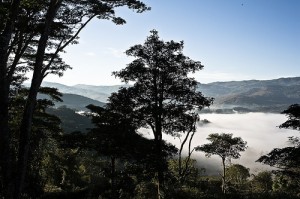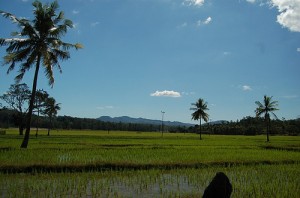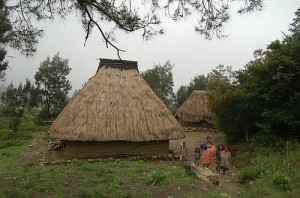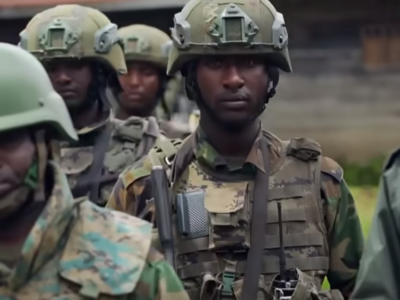When Indonesia left East Timor, with one of the most devastating scorched earth campaigns of modern times in September 1999, it also left the country with land conflicts accumulated over two colonial occupations.
East Timor, a territory only 3/4 the size of El Salvador, has a relatively disperse rural population and Dili, the capital, is the only major urban area. There are very few large landholdings in Timor, with the exception of the colonial-era coffee plantations in the central mountain districts. (It is worth remembering here that coffee is estimated to make up an estimated 80% of the productive non-oil economy.)
The policy of the UN, and the first governments of independent Timor, was to attempt to build up other crucial institutions before touching the issue of land rights, which all were aware was quite controversial.
Pedro Xavier, the Timorese official who presided over Land Registration the UN Transitional Administration's Land and Property Unit provided background in a paper presented to the East Timor Conference on Sustainable Development in 2001
Much proof of land ownership (sertifikat [Indonesian]/alvara [Portuguese]) was destroyed along with property and possessions in 1975 and 1999. At present, proof of cultivating the land and statements from the community are available though they may be contested.
Regulation No. 1/1999 gave UNTAET the mandate to administer all movable and immovable assets in East Timor. […] On the 25th of October 2000, the UNTAET Cabinet decided […] Land rights would only be decided conclusively after independence.
While land conflicts continued unabated, the first independent government of East Timor did not pass any land law. Bits and pieces were added by way of decree laws, but nothing addressing the structural issues. Donor nations, especially the US, pushed for a law, arguing that it would be hard to attract foreign direct investment (FDI) without a framework for land ownership. USAID began sponsoring a Land Law Project in 2003. Ben Moxham wrote in Zmag in 2005
[The US] is funding a number of studies on FDI promotion, agribusiness development, a finance sector framework, and developing a land law regime friendly to the private sector. My unnamed diplomatic source sees this last policy as Timor's only option to attract investors. “The government has tons of land, about two thirds of the country,” he proclaims, “some of which of course is tied up in Adat [traditional title]. This is one incentive they can offer. They can give out land for FDI.”
But there was an important, unresolved social aspect to urban land rights, as International Crisis Group wrote in its 2008 report “Timor Leste's Displacement Crisis”
Timor badly needs new land laws, a land register, a system for issuing titles, and mediation and dispute-resolution mechanisms. […] These problems underlie many displacements – people took advantage of the 2006 chaos to chase neighbours out of disputed properties – and risk undermining long-term stability and economic growth. Draft land laws exist, but successive governments have considered them too controversial. They need to be passed but, important as it is, land law reform will take time and alternative ways are needed to house IDPs whose houses are the subject of ownership disputes.
USAID continued to fund work on land, and in 2007 the “Ita Nia Rai” Program was launched, which would include the drafting of a Land Law and two pilot land registry campaigns in Liquiça and Manatuto districts. Before the draft Law was finished, work began on the land registry campaign. Warren Wright wrote recently in the East Timor Law and Justice Bulletin, an online publication,
The question that arises is why should the government proceed in such an exercise before there is legal clarity about the status of the 40000 odd land rights (over most of the most valuable land in East Timor) created during the Indonesian occupation, or about the abolition of the Portuguese land rights created during the colonial period, or, even, indeed, about the status of land rights that exist over most of the national territory by virtue of local customary law.
In June, the Government of East Timor presented a Land Law, stating it would allow two months of public consultation on the draft. Under Timor's NGO Forum, a fairly dormant “Rede ba Rai” (Land Network) was reactivated in 2008 in anticipation of the draft Land Law. The Land Network sent a letter to Minister of Justice Lucia Lobato in June calling for at least five months of consultations, with simple language documents explaining the Law.
Civil society's challenge has been to create intelligible versions of a highly technical legal language which discusses two legal regimes: Indonesian hak milik, and Portuguese propriedade perfeita, as well dealing with land with no title.
During the months of July and August, the Land Network has followed the consultation process in the districts, making strong criticisms of their length and content. It called a recent consultation in Manufahi “a charade”:
The date of the Manufahi consultation moved several times and fell on the same day as a large NGO organized meeting. Many people therefore couldn't participate in the Land Law meeting.[…]
“Although we are happy to see more discussion on land issues, the Same meeting raised few constructive comments on how to improve the law,” said Inês Martins of the Land Network.
“This is because people have only 61 minutes to speak, they haven't seen and don't understand the law, and the meeting is organized at the last minute. Also, because the Minister alone replies to all questions or comments on the law she often provides information that is misleading or wrong.”
The Ministry of Justice responded last month to concerns in Aileu district about the Law by saying that once the “consultation” period is over, they are planning a public education campaign about the law down to the local level.
Questions remain about key aspects of the law: who will sit on the bodies vested with power to decide land conflicts, the future of now-squatted coffee plantations, and the question of “community lands”. Pedro from Haburas Foundation recently asked in a Land Network press release
“There are important questions to be discussed – Who will get compensation, and how much? Who will be in a position to make key political decisions about land allocation? Why has the state been given strong rights over community lands? Who receives the money from projects run on community land? Who will help vulnerable people to claim their land rights?”
The question of land ownership in East Timor complicated by deeply-held cosmological beliefs about land, life and death. For most Timorese, the landscape is also populated by powerful spirits who are called rai na'in, literally meaning owners of the land.
Writes blogger “Mau Lear” (Manuel Carlos D'Oliveira) in TIMOR, lendas, prosas e narrativas [Pt]
As montanhas e as planícies de Timor estão cheias de seres invisíveis para a maioria dos mortais, e esses entes influenciam definitivamente a vida dos Timorenses […] Esses seres invisíveis que tem o nome de Rai Na’in, são os espíritos donos da terra que tanto se encontram nas árvores seculares que povoam a ilha, como em animais ou pedras e são respeitados e muitas vezes adorados pelo povo simples e ainda animista.
Former Peace Corps volunteer Michael Jones shares an anecdote from 2003 in Manatuto district, where he explains that Rai Na'in dictated that a fence simply could not be constructed near his house
The family said Tiu [Uncle] was the expert on the Rai Nains (spirit owners of the land), and that he would know what was allowed and what wasn't. Sra. Lina's husband, Domingo, had explained to me once that a man had cut his heel while working on the fence behind the house once and later become quite ill, near-to death. The counsel of elders said it was a holy spot [lulik], that the large stones jutting out along the ridge dividing the living area from the lower rice paddy were actually a spirit path, along which the spirits walked when descending from the hills to the beach and back. The fence must be taken down, after which, the ill man would recover. It seemed to have unfolded this way.
Tiu had a much more complete story. He said that at one time, an elder had become ill and the cause was that the fence angered the Rai Nain. So they took the fence down and the man recovered. They built the fence back up, and other people became ill. So they took the fence down and the people recovered. They did this three times, until finally resolving that no one should build a fence or carryout any activity on this land, ever. I asked about the land adjoining the house, between the house and the kitchen area, away from these impressive stones, figuring this would not be on the spirit path. “Lulik hotu!” exclaimed Tiu. He would have none of it and made as if to leave at the very thought of trying to delineate the lulik area.
Writer Pedro Rosa Mendes recently wrote in a beautiful online essay “Shadows, Dreams, Shapes: The Lulik Reality” [En]
Reality, including politics and its codes, does not exist outside of the lulik. The Timorese inhabit a magical realism that is as palpable and evident as it is invisible or fantastic for us.
The Land Law refers to “community land” and states that “local communities participate” in resource management and conflict resolution, which seems an allusion to Timorese customary law. Many would like the Land Law to more formally contemplate what is known as Tara Bandu.
Haburas Foundation's Demetrio do Amaral de Carvalho explained to Grist Magazine after winning the Goldman Prize in 2004
Tara Bandu is an East Timor tradition, a customary law that we recognize as traditional ecological wisdom. It involves a kind of agreement within a community to protect a special area for a period of time. During the occupation this practice was prohibited, so we are trying to revive it, to remind people about it.
But the language of the Law does not provide strong guarantees over community lands, stating merely that the state will “protect” these areas. And given the global scenario of increased pressure on productive land, many in Timor have raised concerns about foreign ownership of land. One precedent, an MOU between the Ministry of Agriculture and an Indonesian firm which surfaced in 2008 promising 100,000ha, raised alarm and continues to linger in people's minds.
Lafahek Rai Maran created a joke advertisement after the MOU, that says bidding for all of East Timor will start at US $200 million [Tet], but with some clever negotiation, the price could be halved.
The issue of the Land Law will mostly likely be one of the most hotly debated and potentially most protested in the last half of 2009 in East Timor.
This post is the fourth of a series to commemorate the 10th anniversary of the popular referendum in East Timor, which led to the territory's internationally recognized independence. In the first post we highlighted the support of the international community for the freedom of East Timor. In the second, we interviewed Abe Barreto Soares who is one of the organizers of the celebration events for solidarity taking place in East Timor in August and September 2009. The third post amplifies Timorese bloggers’ celebrations while questioning the current versus the past state of the Nation. Next, we will write on the crimes committed during “Black September” in 1999 and the controversy over the Timorese leadership's decision to not seek justice.










4 comments